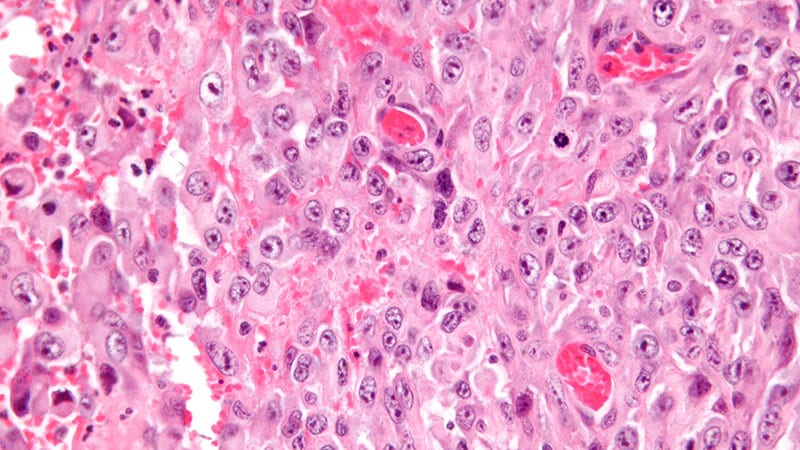The study covered in this summary was published on researchsquare.com as a preprint and has not yet been peer reviewed.
Key Takeaway
-
The combination of irinotecan, vincristine, and the novel Chinese tyrosine kinase inhibitor (TKI) anlotinib may be an effective salvage regimen option for patients with metastatic/unresectable epithelioid sarcoma.
Why This Matters
-
The investigators note that with US Food and Drug Administration approval of the epigenetic modifier tazemetostat for advanced epithelioid sarcoma, “other systemic options are generally ignored.”
-
However, alternative chemotherapy drugs or drug combinations can yield a higher response for patients with advanced disease and should “be considered more in neoadjuvant settings,” the authors say.
-
The findings of the current study suggest that an alternative regimen — irinotecan, vincristine, plus anlotinib — could be an effective salvage option for patients with advanced epithelioid sarcoma.
Study Design
-
The team retrospectively reviewed data from eight patients with metastatic or unresectable epithelioid sarcoma treated with irinotecan (50 mg/m2/d on days 1–5 every 3 weeks), vincristine (1.4 mg/m2 on days 1 and 8), and anlotinib (12 mg every day, with 2 weeks on and 1 week off) on a 21-day cycle.
-
Overall, 54 courses were administered; the median follow-up was 21.2 months.
-
Five patients had unresectable localized lesions, and the other three had unresectable pulmonary metastases. Six of eight (75%) had experienced disease progression with two lines of systemic therapy.
-
Anlotinib was chosen because it was deemed less toxic than other TKI options; tazemetostat was not used because it had not yet been approved in China for the indication when the patients were treated between 2015 and 2021.
Key Results
-
Three patients (37.5%) had an objective response, and disease became stabilized in the other five (62.5%).
-
The 5-year overall survival rate was 83.3%.
-
At the last follow-up, two patients were still receiving the combination; three patients had ceased therapy, owing to toxicities; one patient had switched to tazemetostat; one stopped because of COVID-19; and the eighth stopped after residual lesions radiated.
-
The most common grade 3/4 adverse events were myelosuppression, diarrhea, and nausea/vomiting.
-
A previous investigation found a lower objective response rate of 15% with tazemetostat for patients with locally advanced or metastatic epithelioid sarcoma; however, tazemetostat was associated with a better tolerability profile, and adverse events were mostly mild and tolerable.
Limitations
-
It was a retrospective study with only a handful of patients.
-
Because most patients ceased treatment for reasons other than progression, progression-free survival could not be calculated.
-
The objective response rate, on its own, is not adequate for assessing treatment activity.
-
Patients were heavily treated with surgery, radiation, and other biological agents, making interpretation of the data difficult.
Disclosures
-
The study received no external funding, and the investigators did not report any relevant financial relationships.
This is a summary of a preprint research study, “A Potential Alternative Systemic Treatment Option for Epithelioid Sarcoma,” led by Lu Xie of Peking University People’s Hospital, China, provided to you by Medscape. The study has not been peer reviewed. The full text can be found at researchsquare.com.
M. Alexander Otto is a physician assistant with a master’s degree in medical science and a journalism degree from Newhouse. He is an award-winning medical journalist who has worked for several major news outlets before joining Medscape and also an MIT Knight Science Journalism fellow. Email: [email protected].
For more news, follow Medscape on Facebook, Twitter, Instagram, and YouTube.
Source: Read Full Article
